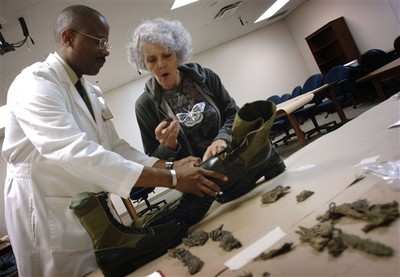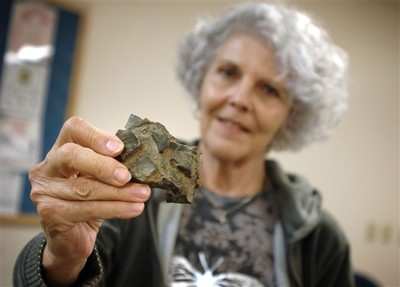If This Doesn't Bring A Tear To Your Eye...
Sallie Stratton always knew she wanted to write a book, but she
just couldn't bring herself to put pen to paper -- until now.

It is truly a Texas-sized love story that starts nearly 50 years
ago in small record store near Dallas. It chases a pilot's dream
around the globe to a foreign land, turns on its end in a fiery jet
crash, returns to a grief-stricken widow and three small boys, and
ends in a southwestern cemetery just last year.
Chuck was Stratton's first love. On New Year's Eve in 1959, the
young man bent on flying for the Air Force happened into the record
store where Stratton was working and tried to flirt with her. She
was busy closing the shop, so he had to buy a record to get her
attention, Stratton said. Though she wouldn't break her date that
night to go out with him, she did yield her phone number.
They went out a few days later, and Chuck proposed within a
month. But, Stratton was only 17 and had yet to finish high school.
Chuck was set for pilot's training for the Air Force. So after she
finished school and he finished training, they married. The two had
a one-night honeymoon and left for their first duty station the
next day.
"I knew it was Air Force from the time I met him. He was a
flyer, and that was what he was going to do," Stratton said.
 The two would spend the next decade
traveling from base to base and starting a family. But the war in
Vietnam was raging, and January 3, 1971, found Capt. Charles W.
Stratton with a fellow pilot, Maj. James H. Ayres, flying an F-4E
Phantom II, a long-range supersonic fighter-bomber, on a night
mission over Savannakhet province, Laos.
The two would spend the next decade
traveling from base to base and starting a family. But the war in
Vietnam was raging, and January 3, 1971, found Capt. Charles W.
Stratton with a fellow pilot, Maj. James H. Ayres, flying an F-4E
Phantom II, a long-range supersonic fighter-bomber, on a night
mission over Savannakhet province, Laos.
The two made a dry pass over the target, but did not drop their
bombs. The plane did not return from its second pass.
Pilots flying nearby reported seeing a large explosion on the
ground. No one saw anyone eject, and communication was lost with
the jet. Hostile activity in the area prevented any search and
rescue attempts, according to reports.
Stratton and Ayres were listed as missing in action that
day.
While Chuck was deployed, Stratton had moved back to Dallas to
live with her mother. She thought it would be a good opportunity
for their three boys, ages 3, 5, and 8, to spend time with
grandparents.
The next morning at 6 am, there was a knock on her door. An
officer read to her a brief telegram detailing the facts of the
night's events, then turned and left to relay the same information
to Chuck's parents.
And Stratton began grieving, and waiting.
"Human beings, ... we can survive anything, if we know what it
is we're surviving," Stratton said. "I think that the unknown is
probably the most difficult situation to be confronted with. We
want to know. We want to know the answers."

Stratton said she knew it was likely her husband had died in the
crash. But because no body was recovered and no one knew for
certain, there was always a question of whether he was still alive
and held in a prison camp. So she waited to hear something --
anything -- that would let her know for certain one way or the
other. But information was not forthcoming.
"We didn't get any information for the first couple of years,
while the war was going on," Stratton said.
She pinned her hopes on the January 27, 1973, peace accord that
put an end to the war and the US military involvement. US prisoners
of war were to be released and returned home. Foreign and US
military officials both promised lists of those who were held in
the various prison camps.
Stratton received word via another telegram; this time an
officer read it to her over the phone. There would be no such list
from Laos, so her husband would continue to be listed as
missing.
"I believed for years that Chuck was alive -- that he had
survived the crash," Stratton said. "I clung to the dream I had of
him where he was a POW. That dream gave me the hope I needed to
survive at the time. I was so sure he would be on that list in 1973
and come home to us."
By 1977, Stratton had gone back to college, become active
politically with other wives of POWs and served on the board of
directors for the National League of Families, an organization for
family members of servicemembers taken prisoner or missing from the
Vietnam War.

And she had come to a point at which she needed to resolve her
husband's case, Stratton said.
"By then, I decided I needed to figure what was going to happen.
It was pretty obvious I wasn't going to get much of an answer at
that point," she said.
Stratton decided she would request a status review of her
husband's case by the military, she said, though she knew it would
result in his being classified as presumed dead.
"There was this fear that if I have a status change, I'm killing
him off," she said. But a status change would allow for his
insurance to be paid and other benefits to begin. It also would
allow her to be free socially to date or remarry.
"At that point, I really didn't think I would ever know
anything. It was just one of those things we'd have to live with,"
Stratton said. "I had done everything I knew to get an answer, and
there wasn't an answer."
She spent months considering her options and finally decided
that the status review was best for her and her sons. And, Stratton
said, she knew her husband would have supported her decision.
Promoted twice during his time listed as missing, Lieutenant
Colonel Stratton officially was classified as presumed dead July 8,
1977.
The family went through the motions of a memorial service.
Stratton said she really didn't want to, but she knew it was
important. Surprisingly, after the service, it was as if her
husband had rejoined the family, Stratton said. They told stories
about Chuck, and the children began remembering little things about
him, she said.
"It had become very apparent that we didn't talk about Chuck
[before]. And the boys particularly didn't talk about their daddy,"
she said. "How do you talk about somebody you haven't seen in
forever? If you talk about him as if he's alive, it feels weird.
... But if you talk about him as if he is dead, then you are
killing him off."
 For the most part, after the service, life
moved on for Stratton. She traveled, taking different jobs. She
lived abroad for a few years. And she almost forgot about the
nagging question of what really happened that night her husband
didn't come home.
For the most part, after the service, life
moved on for Stratton. She traveled, taking different jobs. She
lived abroad for a few years. And she almost forgot about the
nagging question of what really happened that night her husband
didn't come home.
But from time to time, things happened to remind her that she
never really knew.
Around 1992, rumors circulated that American POWs were being
kept in Laos near where her husband's jet crashed. A native even
identified her husband from a photograph as one of the POWs kept
there. The military discounted the reports, though, and did not
view the source as credible.
Then, in 1999, Stratton was back in Texas, living with a friend
in Houston. She received a letter from the Defense Department's
POW/Missing Personnel Office. The Washington, DC-based office is
charged with developing the policy and overseeing the efforts of
the nearly 600 men and women in a handful of agencies across the
country who work to research, recover and identify those who still
are listed as missing from past wars.
People assigned to the office travel across the country a dozen
times each year to update families on the status of missing
servicemembers. The next meeting was nearby and Stratton decided to
attend.
There, she found out that her husband's crash site was next on
the list to be excavated by a team from the US military's Joint
POW/MIA Accounting Command on its next visit to Laos. The command
sends out research and recovery teams on about 70 missions each
year. The JPAC is based in the US Pacific Command and conducts 80
percent of its missions there. It has identified nearly 1,500
formerly missing servicemembers.
"I didn't realize that they were still excavating and that they
were really going to those lengths," Stratton said.
While she was excited about the possibility of finally knowing
whether her husband died that night, Stratton said original
questions she had tried to quell began to resurface.
"It was almost like replicating those first few years of waiting
for information," she said. "It's like [you feel] that hope again
that you're finally going to get an answer. We started the waiting
game again."
It would be five years before the site was fully excavated and
all remains were recovered.
In 2001, a joint US/Laotian team, led by the JPAC, traveled to
Savannakhet province and interviewed citizens about aircraft crash
sites. One of the men led the team to what was believed to be the
Ayres and Stratton crash site, according to military reports. Later
that year, another team began excavating the site. The team
recovered human remains and aircrew-related items. Between 2002 and
2005, joint teams visited the site six more times to complete the
excavation.
 Stratton received detailed
reports from each trip. And finally, she learned that the teams had
found bones and possible material evidence. Pieces of flight suits,
boots, and a survival vest were found.
Stratton received detailed
reports from each trip. And finally, she learned that the teams had
found bones and possible material evidence. Pieces of flight suits,
boots, and a survival vest were found.
In August 2005, Stratton found herself at the Life Sciences
Equipment Laboratory in San Antonio. The lab supports the JPAC
mission and deals mostly with identifications from aircraft crash
sites, because they are less likely to yield human remains. The
heat, fed by jet fuel and loaded munitions, incinerates most human
remains as temperatures reach several times those of a
crematorium.
But many pieces of military uniforms and equipment will
withstand those temperatures. Most times, the equipment analysts at
the lab are able to piece together with scientific accuracy the
likely final moments of servicemembers based on the artifacts.
Analysts estimate that with the full bomb load that Chuck's jet
was carrying that night, temperatures would have been eight times
that of a crematorium. Yet they recovered 58 pieces of flight suit
material.
Using those, analysts pieced together two right-leg pencil
pockets -- evidence that both pilots were in the crash. Also, boot
sole material was recovered. The tread on military boots made
during the Vietnam era varied, and analysts found boot sole
material with two different treads.
"Looking at that, it was like 'This was just incredible.' I felt
so blessed," Stratton said. "I never thought I would get that much
of a definitive answer. Now I know that he wasn't ever a prisoner.
He died instantly on the third of January, 1971. That felt ...
comforting to finally know."
That would not be the only evidence that her husband had died in
the crash. The small amounts of bone material found at the site
remarkably had rendered DNA, allowing technicians at the Armed
Forces DNA Identification Laboratory in Rockville, MD to help
conclude that the remains were those of her husband.

The lab also supports the JPAC mission and extracts the DNA of
800 bone and tooth samples each year provided by the JPAC. DNA
testing, once deemed unreliable by the scientific community, has
developed to become a key piece of evidence in nearly 85 percent of
all missing troop identifications.
On July 5, 2007, Stratton finally got the call she had been
waiting on for more than 35 years.
"I was just like dumbstruck," Stratton said.
She said she asked the officer from the DNA lab on the other end
of the line about a "buh-zillion times" if he was sure of the
results. He was.
After she got of the phone, Stratton said, she walked only a few
steps and stopped.
"There was just this wail, this scream ... this grief that just
came up I think from my toenails. I cried like I have never. It
just erupted," she said. "Getting the positive DNA [results]
unleashed grief that was still buried somewhere in my body. It was
just amazing."
So the family had another funeral service last year for Chuck.
In stark contrast to his first funeral decades earlier, hundreds of
family, friends, grandkids, and even some of Chuck's old cadet
buddies gathered October 9, 2007, at the Dallas-Fort Worth National
Cemetery for what turned out to be more of a celebration than a
memorial.
"It was like Dallas and the world welcomed Chuck home. It was
absolutely awesome," Stratton said. "We laughed. We cried. We told
stories. We celebrated his life from beginning to end. And it was
just awesome."
But, truth be told, Chuck is not buried under the stone in the
cemetery. Stratton chose to keep her small bone fragments with her
in an urn. The two pieces of bone, thought to be the two ends of
his thighbone, are roughly the size of a thumbnail.
"He was gone a long time. He's going to stick around for a
while," Stratton said.
Stratton has dated other men, but never remarried. She has never
checked the "widow" block on a form. In some ways, she said, that
question was always there.

Stratton is now writing a memoir of her experiences. She had
always wanted to, she said, but had not been able to start.
Stratton said she cried and wrote in her journal for four days
after hearing of the DNA results. It was then, Stratton said, that
she knew she could write her book.
"This is why you haven't been able to write your story yet,"
Stratton said she realized. "It didn't have an end. Now [I] have an
ending."
(Aero-News salutes Fred W. Baker III, American Forces Press
Service... who in our experience has a particularly
deft touch with stories like this one --
Ed.)
 ANN's Daily Aero-Term (04.14.24): Maximum Authorized Altitude
ANN's Daily Aero-Term (04.14.24): Maximum Authorized Altitude ANN's Daily Aero-Linx (04.14.24)
ANN's Daily Aero-Linx (04.14.24) Classic Aero-TV: 'We're Surviving'-- Kyle Franklin Describes Airshow Life 2013
Classic Aero-TV: 'We're Surviving'-- Kyle Franklin Describes Airshow Life 2013 Aero-News: Quote of the Day (04.14.24)
Aero-News: Quote of the Day (04.14.24) Airborne 04.09.24: SnF24!, Piper-DeltaHawk!, Fisher Update, Junkers
Airborne 04.09.24: SnF24!, Piper-DeltaHawk!, Fisher Update, Junkers









